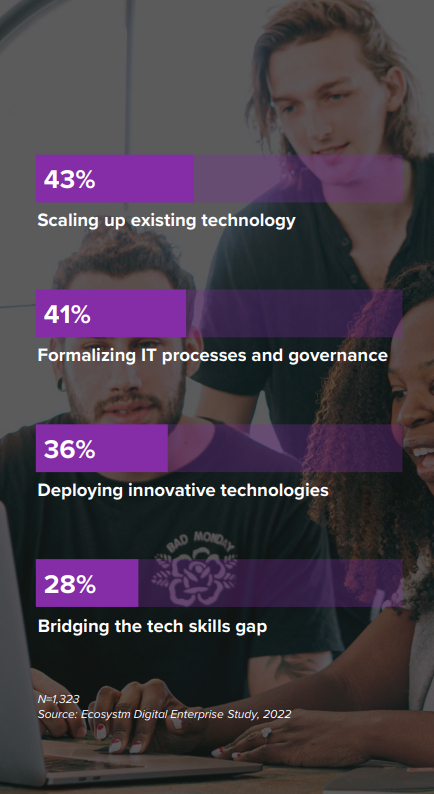Tech Teams Need Service Providers
CIOs and tech teams have seen a sharp shift in their mandates and find themselves delivering on business and customer outcomes, rather than just technology. They are partners in their organization's transformation vision; and find themselves:
- Defining the organization's cloud strategy
- Modernizing applications and infrastructure
- Revamping the data architecture
- Proactively securing the IT environment
- Managing and evolving business continuity plans
The biggest business priorities driving tech investments are innovation, improving customer experience (CX) and enhancing employee productivity and experience.

Download the complete guide to Solving Your Customers Work From Anywhere Challenges
Shift in Tech Team Priorities Driving MSP Engagements
As the mandate broadens for tech teams, more often than not they will find themselves underprepared - this offers immense opportunities for their manages service provider (MSP) partners.
However, there will be a shift in the way they engage with their technology vendors and MSPs; in their procurement strategies; and their vendor evaluation criteria.
They will engage with MSPs that are customer-focused, constantly innovate on their products and delivery models, offer value-added services and are able to support organizations achieve their business goals.

Organizations Want to Enhance Employee Experience – Can You Support Them?
Ecosystm research finds that as high as 45% of employees are looking to change careers/ jobs in 2022. Employee Experience (EX) is a key business priority especially as organizations formalize their hybrid work strategies.
What organizations need help with:
- Constant monitoring of network and device performance
- Ensuring that every complaint on the UC environment is addressed – such as camera, voice, video, collaboration and
headset issues - Regular update of business-critical applications that are accessible from remote environments
- 24/7 support tech support to their employees as work hours become increasingly flexible
- One dashboard for proactive monitoring and failure management
Real-Life Problems of Employees
| Interoperability
|
Video issues
|
Voice issues
|
Issues in Huddle Rooms/Open Spaces
|
Headset issues
|
It is time for MSPs to focus on building capabilities in end-to-end monitoring across devices, spaces, offices, networks and applications to solve their customers’ issues proactively. This will create the market differentiation they need to grow market share.
Ecosystm Opinion
One of the areas that MSPs are seeing growth opportunity is in supporting customers' Hybrid Work requirements. Organizations need MSPs for UC and cloud services, implementation of latest technologies and a service management layer. In a competitive market, it is vital for MSPs to create product and market differentiation. They can no longer win and retain business by delivering basic support services.
IT teams facing increasing challenges will rely on best-in-class services and innovations from their MSPs.
The Right Tech Partnership Can Empower MSPs
Where MSPs face the most challenges
Managing a multi-vendor environment
UC platforms often include multiple vendors, platforms which are a combination of on-premises, public cloud or hybrid cloud solutions. MSPs are challenged with the requirements to manage and monitor the performance of applications in a complex multi vendor set up. It is not easy to achieve 100% optimal performance.
Providing customers with a single point of a management and visibility
Many service providers still manage end points and solutions disparately; and are unable to offer their customers a single point of interaction.
Ensuring that SLAs are managed effectively
The entire UC stack comprising collaboration, voice, video and overall cloud services, use different vendors with different SLAs. These different terms and services need to be managed effectively to ensure that there is continuity in the service with high levels of guarantee.
Handling Customers’ Work from Anywhere Challenges Requires MSPs to Have Unique Capabilities
Experience Testing
Experience matters in the new era of work. MSPs have to ensure optimum employee experience across multiple locations. Continual testing to ensure capacity, performance, stability and resilience is an essential capability.
Security
The MSP's role is not only to build the right security setup for the enterprise but constantly re-visit security and back-ups protocols; and proactively monitor any form of threat or vulnerability.
Innovation and Improvements
MSPs must introduce new technologies and best practices along the way; and be an advisor that can help organizations buld and improve the Work from Anywhere model as it evolves.
Proactive Troubleshooting
Hybrid workspaces are increasing becoming complex - remote access and physical workplaces have their own distinct challenges and issues. The aim should be to preempt and address issues as they arise (or even before) for both remote employees and those working from the office.
Analytics
MSPs must be able manage and provide the visibility on UC infrastructure through dashboards and reporting tools. They must ensure that the enterprise infrastructure has the best Quality of Experience (QoE) and Quality of Service (QoS).